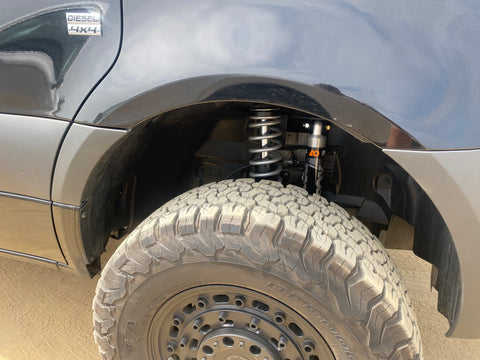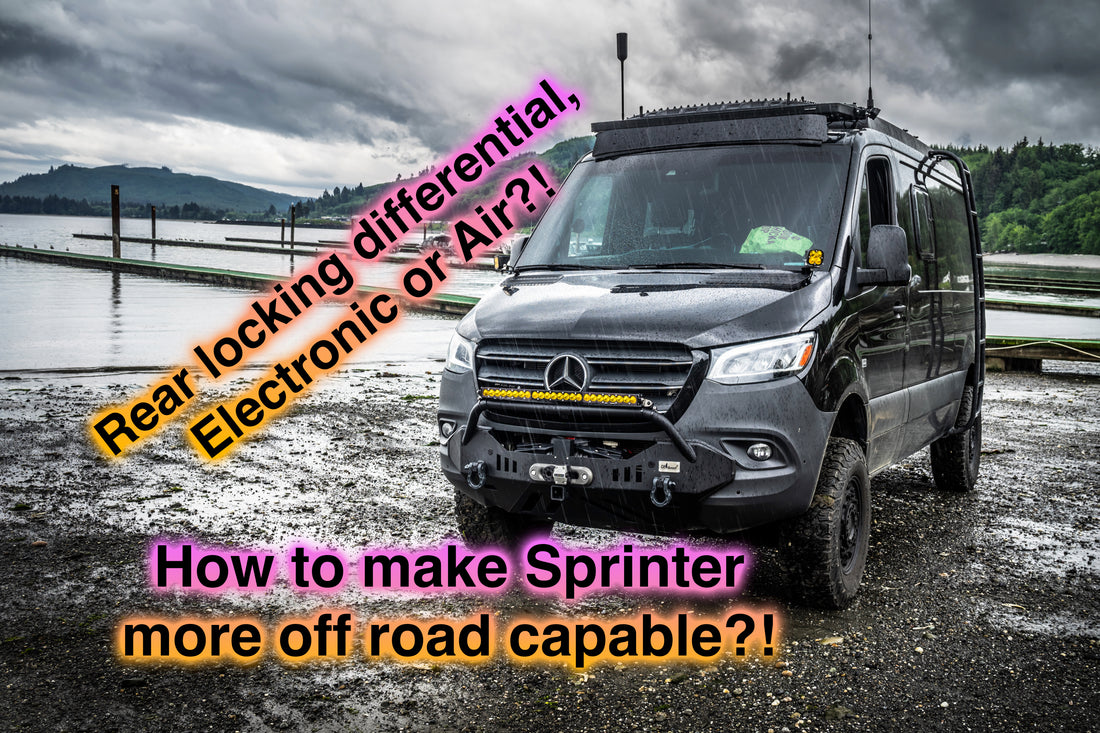Sprinter 4X4 (VS30 / NCV3) have 4hi, 4lo, 2wd, and 65:35 ratio in 4x4, which is their main downside since it means that most of the power isn't equally transferred between the front and rear tires. Sprinter’s Adaptive ESP prevents rollover and the 4ETS traction control is already quite more capable than many true mechanical 4x4. However, not having 50:50 ratio even in 4 Low, in addition to not having a locking differential is a predicament when pushing the limits on jeep trails.
Prior to recent innovations from companies like Agile Offroad, Van Compass, and Owl Vans, the only way to truly make the Sprinter very capable off road required a full 4x4 rebuild from Arctic Trucks or the German company Iglhaut Allrad. If you are not familiar with those two company, they can transform a Sprinter RWD into a true 4x4 by installing SAS Dana 60 front and rear axles with locking differentials, add a 50:50 3 to 1 transfer case, and even CTIS for the arctic (see video at 2:00). If you ever saw the 170 Sprinter called "Bruce Banner" then that's what I'm talking about (see below). Even if these Sprinters conversions still are king of the mountain, doing such upgrades is extremely expensive, requires major modifications, and is logistically complicated. Luckily in recent years, new aftermarket upgrades are available to increase the off road ability of most Sprinter vans.
 (Bruce Banner 37" Sprinter 4x4 SAS)
(Bruce Banner 37" Sprinter 4x4 SAS)
Knowledge is most important, please watch videos, take classes, and slowly build your skills on how to drive off road before attempting something too much out of your comfort zone. That being said, 4x4 is the most valuable upgrade off road, but whether you have that feature or a 2 wheel drive, here are some upgrades anyone can benefit from to improve the off roading ability of your overland Sprinter:
#1 Bigger All Terrain Tires: 245 factory size with street tread isn't enough for such a large vehicle, going to larger 275 all terrain or mud tires will dramatically increase clearance of approach (front), departure (rear), and most importantly break-over angle (center). It will also increase the vulnerable height of the rear differential. Traction will also improve on uneven terrain since your tire will reach the ground, even when you max-out your travel (suspension fully extended). For more information on larger tires, see this page.
 (Sprinter 4x4 275 tires / factory suspension)
(Sprinter 4x4 275 tires / factory suspension)
#2 Air Compressor (deflate tires): An air compressor is needed because you will want to deflate tires to greatly improve traction by widening the width of the tire. Wider flexible tires means more contact with the ground, thanks to the rubber molding around rocks or roots, and improved flotation over soft surfaces such as sand. Lower tire pressure also allows the flexible rubber to shake away the mud off the treads to maintain traction. However, once you deflate, you will need to re-inflate your tires back-up to drive on the paved roads, hence the need for an air compressor. See this page for air compressor suggestions and tips to inflate and deflate tires quickly.
 (ARB Air twin compressor / AO plate under hood)
(ARB Air twin compressor / AO plate under hood)
#3 Suspension: Upgrading your suspension will improve traction by making sure your tire stays on the ground through proper rebound and shock absorption, you will be rocking less right to left after each bump, and it will increase a little your travel by extending your suspension stretching ability. See this page for suspension upgrades options.
 (Agile Offroad front Suspension Sprinter)
(Agile Offroad front Suspension Sprinter)
#4 Locking differential: Whether 4x4 or RWD, rear locking differential can make a huge difference when one of your rear wheel doesn't have traction by being in the air or on a very loose surface. On paved road, when taking a turn, you want the wheel that is on the outside of the curve to be turning faster, to travel greater distance, than the wheel on the inside. But off road, you sometime want both wheels to be spinning at the exact same speed; a locker will prevent power from being sent to the wheel with the least amount of resistance, which is greatly beneficial on uneven terrain off road. Upgrading to a rear locker also means that you will have the opportunity to change differential gear size to compensate for the loss of power associated with larger tires. See below for more info on which locking differential is available. (See below for more info).
#4.1 Limited Slip Differential: Another option, instead of a locking differential, would be OHV (Off Highway Van) limited slip with 3.92 gearing. Since Sprinters, even 4x4 models, do not have this feature from factory, it can greatly improve performance on low traction environments such as snow, ice, and heavy rain by automatically sending power to the spinning wheel which works in conjunction with the factory 4ETS traction control. Not as effective as a locking differential on uneven terrain off road, it is still a great option, mostly for 2wd / RWD vans, who want to improve performance during inclement weather, knowing that they will never bring their van on tricky jeep trails. Always on, and no air compressor or ECU update needed, it's a hassle free upgrade that increases everyday on road traction. It is also great for light off roaders who mostly want to improve traction in order to get back on paved road from their campsite or ski parking spot.
 (OHV LSD Sprinter)
(OHV LSD Sprinter)
#5 Recovery gear: Ok, it doesn't make it more off road capable, but it does make it more responsible. Since off roading often means being remote from civilization, it also means that if you get stuck, which is likely, you will need to be able to get yourself unstuck. Otherwise you may need to pay for an expensive towing fee to come and reach you far in the outback or you will need to call Matt's Offroad Recovery ;-) Example of recovery gear include, at a minimum, traction boards such as MaxTrax or Tred Pro. Also hitch towing hook, recovery strap, shackle such as the ones from Factor 55 so that another vehicle can pull you out. If you are often exploring alone in remote places, I would also invest in a 12k winch such as Warn with a bumper such as the one from CA Tuned, with an anchor / tree saver such as the Deadman Offroad.
#6 Armor protection: Similar to recovery gear, it won't improve your abilities; but since damage is more likely off road, you can avoid expensive repairs by installing Van Compass skid plates over vulnerable components. The most important skid plate on a Sprinter is for the rear differential, which is known to leak after hitting a rock due to a fragile cover. Another at risk part is the low hanging and expensive transfer case. VC also offers sliders but that much steel and weight isn’t ideal on a unibody. Installing high clearance steps that follow along the length of the vehicle, will already protect greatly the rocker panels.
Who offers a rear locking differential for the Sprinter platform and which one to choose?
The first generations of Sprinter air lockers are available from Agile Offroad (AO) who collaborated with the famous ARB. It includes ECU module update and you will need to add an air compressor if you don't already have one. The AO offering came out first, which makes it more popular and is proven to work well. Being made in collaboration with ARB from Australia who is the number one manufacturer of air locker in the world also offers confidence in the quality. The installation though is complicated and I highly recommend going directly to AO headquarters near San Diego to make sure the installation was done correctly. See video at 5:57 to watch the locker being used in Moab. See video at 2:55 to watch John from AO going over the ARB differential.
 (AO / ARB air locking differential demo)
(AO / ARB air locking differential demo)
Owl Van also offers a new rear locking differential offering that is actually a full Dana 60 rear axle replacement. It has a strong 35 spline (29 oem) chromoly shaft and it is an electronic rear locker. As such, it doesn't require an air compressor. Owl Vans includes the RennTech re-gear module to update the ECU. Dana axles and e-lockers are also proven in the off road industry, the main advantage is that the internal parts are universal and can easily be fixed most places in the world. Other advantages are that you get a stronger axle than factory and it can more easily be installed by mechanics or handy DIY folks. Downside is that if you can't install it yourself or for cheap, it will cost more than the AO ARB locker. Also, as explained below, electronic locker isn't as capable as an air offering. See video at 3:18 for John from Owl Vans presentation of this product.
 (Owl Vans / Dana 60 e-locker axle)
(Owl Vans / Dana 60 e-locker axle)
Which is better an air locker or an electronic differential locker?
Air lockers:
Pro: Locks almost immediately and it can be locked while driving at low speed. Also doesn't get as hot which tends to improve durability under continuous stress.
Con: Requires an air compressor properly installed with no air leaks to function properly which increases cost.
Electronic locker:
Pro: Does not require an air compressor which reduces issues relating to air leaks and lowers cost. It is also easier to fix since parts are often more accessible.
Con: Delayed engagement since it functions with an electromagnet with cams and metal beads. As such, it requires a quarter to half a tire spin going forward before engaging, same when switching into reverse. Can not be engaged while driving.
Can I get 50:50 gear ratio on a Mercedes Sprinter VS30 or NCV3?
Maybe! Early 2022 at the Overland Expo West, John from Agile Offroad showcased a 3:1 mechanical transfer case that offers true Atlas 2-speed 50:50 ratio for front and rear tires. It includes a manual shifter for 4hi, 4lo, and 2wd near the parking brake. If you go to AO headquarters, you will be able to see a Sprinter with that transfer case installed. However, as of December 2022, it still doesn't appear for sale, so let's hope that it will make it into production.
 (AO Atlas 2 speed Sprinter 50:50 transfer case)
(AO Atlas 2 speed Sprinter 50:50 transfer case)
Note: Newer 2023+ Sprinter AWD comes with 50:50 ratio from factory when all four wheels are engaged (AWD can not be engaged full time). Furthermore, it no longer has 4 low gearing in transfer case (not 4x4 anymore) which will affect off road abilities; but it now comes with a 1st gear that is lower to try to compensate. AWD and 4ETS also behaves more negatively when one wheel is in the air, so I recommend a rear locker as a more important upgrade for AWD models, see AO video for comparison. However, such configuration will improve traction and ease in 4wd at higher speed on fire roads and paved road during inclement weather since it engages automatically while moving. Also, the turbo V6 is no longer available, it was replaced with a similar power twin turbo 4cyl diesel option that is more compliant with biodiesel. Long term reliability of a 4cyl on a 10k+ pounds conversion remains to be tested.


8 comments
Eaton’s Dana 60 brochure says that the Elocker fully engages .14 seconds after flicking the switch so, I would move that feature from the con list to the pro list. It’s probably the fastest locking mechanism out there.
Thanks Don! 👍
Nice explanation’s